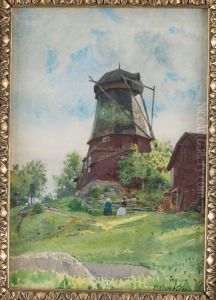Tryggve Hermelin Paintings
Tryggve Hermelin was a Swedish artist, primarily known for his work as a painter and a printmaker. Born on May 18, 1864, in Karlskrona, Sweden, Hermelin grew up in a period of significant change in the Swedish art world, as artists began to move away from traditional academic painting and sought new means of expression.
Hermelin began his formal art education at the Royal Swedish Academy of Fine Arts in Stockholm, where he studied from 1882 to 1887. Following his education, he embarked on a series of travels that took him across Europe, which was a common practice for artists of the time to gain exposure to different artistic styles and techniques. He spent time in France, Italy, and Germany, absorbing influences that would later impact his work.
Throughout his career, Hermelin exhibited a diverse range of subjects in his art, including landscapes, portraits, and genre scenes. His style was characterized by an attention to detail and a commitment to realism, although he also incorporated elements of Impressionism, particularly in his use of light and color. Hermelin was a part of the Opponenterna, a group of Swedish artists who opposed the strictures of the Royal Academy and advocated for more progressive approaches to art.
Aside from his painting, Hermelin was also known for his work in printmaking. He created a number of etchings and lithographs that gained recognition for their technical skill and artistic merit. His prints often featured landscapes and cityscapes, capturing the changing environments of Sweden at the turn of the 20th century.
Tryggve Hermelin's contributions to Swedish art were recognized during his lifetime, and he was awarded several honors and medals for his work. He passed away on February 18, 1940, in Stockholm. Today, his works can be found in various art collections and museums, serving as a testament to his skill and dedication to his craft as an artist.
